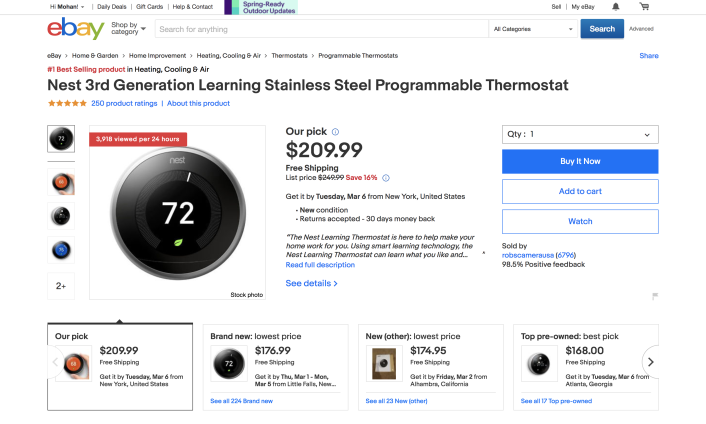With the Product-Based Shopping Experience (PBSE), buyers will be able to easily find merchandise that meets their search criteria, and quickly decide which products they want to purchase. Please visit our Seller Center for more information on listing with structure data. Note that sellers and developers have the option of integrating with PBSE using the traditional Trading API or the new REST-based APIs.
Table of Contents
- Introduction
- PBSE Phase 1
- Phase 1 categories/brands
- Phase 1 recommended workflows using REST APIs
- Phase 1 recommended workflows using Trading API
- PBSE Phase 2
- Phase 2 categories
- Phase 2 recommended workflows using REST APIs
- Phase 2 recommended workflows using Trading API
- How-tos
- Using Compliance API reason codes to revise listings
- Associating catalog products to special listings
- Product aspects vs. item specifics
- Testing Product-Based Shopping Experience APIs in sandbox
- Testing Product-Based Shopping Experience APIs in production
- FAQs
Shopping experience
Ensuring our sellers' success starts by delivering a powerful and differentiated shopping experience showcasing eBay's unique value and selection. Making this come to life requires products to replace listings as the anchor of our experience.
The Product-Based Shopping Experience will be surfaced to buyers based on specific buyer queries, directly matching the products and categories identified as part of the experience.
The Product-Based Shopping Experience is currently available on US, UK, Canada (English), Australia, and Germany sites. The product information will be consistent, coming from the eBay Catalog, but the seller's item-specific information will also available if applicable.
Examples of a Product-Based Search Results Page and the Product Page for a Nest Thermostat are shown below:

Figure 1: Search Results Page with Product-Based Listings
Once the user selects any of these product cards, that particular product will be loaded into an eBay product page, as shown below:

Figure 2: eBay Product Page for Nest Thermostat
eBay will be rolling out new versions of this experience in the US, UK, CA (English), AU, and Germany sites throughout 2018, and making it the default experience in some search results in coordination with new seller requirements as described below.
Product-Based Selling: Overview
The Product-Based Shopping Experience (PBSE) requires listings to be associated with a product in the eBay Catalog. To create a new listing, or to revise an existing listing using a catalog product, sellers will need to provide the unique identifier of the product in the eBay Catalog, referred to as an eBay Product ID (or ePID).
PBSE is rolling out to the US, UK, CA (English), AU, and Germany sites in two phases in 2018. The Shopping Experience above will be released for the brands and categories in each phase after the Seller Experience enforcement begins. This playbook covers the new functionality and recommended workflows for developers in both Phase 1 and Phase 2 of PBSE. Note that only Phase 1 categories will enabled/enforced for Germany in 2018, but Phase 2 categories will roll out to Germany in 2019.
PBSE Phase 1
-
Phase 1 product lines within certain categories require association with an eBay Catalog product. This requirement began in May 2018.
-
The products impacted by Phase 1 have been manually curated within the eBay Catalog to ensure that all of the product details are accurate.
-
Sellers will be required to search the eBay Catalog and list or revise single-variation listings with the eBay Product ID (ePID), and each variation within a multiple-variation listing with a Global Trade Identification Number (GTIN) such as UPC, EAN, or ISBN .
-
The PBSE requirement applies to all item conditions and listing formats.
-
See the New APIs and Updated APIs and feeds sections of the Product-Based Shopping Experience landing page to get a high-level view of the new functionality that has been released to support PBSE Phase 1.
-
For details on integrating with PBSE requirements, see the Phase 1 recommended workflows using REST APIs or Phase 1 recommended workflows using Trading API topics.
PBSE Phase 2
-
All listings in Phase 2 categories will require association with an eBay Catalog product beginning in mid-September 2018. Phase 2 will affect full leaf categories, including all Phase 1 categories (except for Cell Phones & Smartphones (Cat. ID 9355) and Tablets & eBook Readers (Cat. ID 171485)). These two leaf categories will not be fully-enabled with PBSE functionality until early November 2018, and not enforced until 2019.
-
We recognize that products may not be in the eBay Catalog yet, or may need to be updated, so Catalog change requests functionality was added to both our Catalog API and on the eBay sites to add and update products in the eBay Catalog.
Note: The three Catalog change request method were decommissioned in Q1 2020. -
Sellers will be required to search the eBay Catalog for their product. If their product is not found, sellers should make a request to eBay to add it to the eBay Catalog. If their product is found with incorrect or missing product details, sellers should make a request to eBay to update the product in the eBay Catalog.
Note: The three Catalog change request method were decommissioned in Q1 2020. -
The PBSE requirement applies to all item conditions and listing formats.
-
Once the product is found/added/corrected, sellers will be required to include the ePID when listing or revising both single-variation listings and each variation within a multiple-variation listing.
-
See the New APIs and Updated APIs and feeds sections of the Product-Based Shopping Experience landing page to get a high-level view of the new functionality that has been released to support PBSE Phase 2.
-
For details on integrating with PBSE requirements, see the Phase 2 recommended workflows using REST APIs or Phase 2 recommended workflows using Trading API topics.